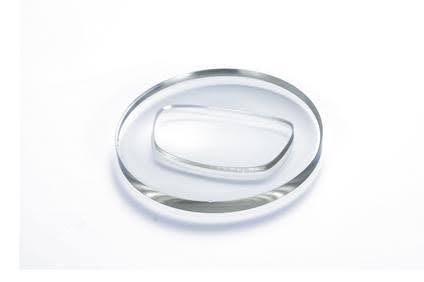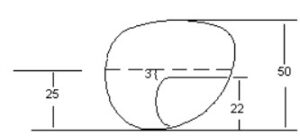
Mastering Minimum Blank Size: Your Practice Exercise for Ophthalmic Frames
Minimum Blank Size
The minimum blank size is the minimum size of a lens blank that can be used to fit the frame chosen for an order. In order to calculate the minimum blank size, you must know how to calculate decentration. The formula used for minimum blank size will depend on the type of lens you are calculating for.
The formula for determining the smallest possible lens blank which will work for any given frame and PD combination is as follows:
Minimum Blank Size (MBS) = (GCD – PD) + ED
In the examples on the previous page, the ED is the same as the A measurement since the frame illustrated is round. Therefore, the theoretically smallest lens size that can be used in Example A is 44 mm. The theoretically smallest lens which can be used in Example B is equal to 48 mm.
Example A:
MBS = (64 – 64 ) + 44 = 44
Example B:
MBS = (64 – 60) + 44 = 48
These minimum blank sizes are considered to be theoretical for two reasons:
-
Two to three millimeters should always be added the the MBS to allow for imperfections such as chips or bubbles which may exist along the periphery of an uncut lens.
-
Lens sizes are available from the manufacturers only in certain predetermined sizes, the diameters of which usually range from 60mm – 80 mm in 5-6 mm increments.

In the example on top since B = 50 mm, the datum line is 25 mm from the bottom of the lens. With a seg height of 22 mm, subtracting half of B from the seg height gives: 22 – 25 = -3. So, the segment line is 3 mm below the datum line (seg = -3). If the seg height were 28 mm, the result would be +3 mm, positioning the seg line 3 mm above the datum line (seg = +3)
Single Vision MBS
If you are determining the MBS for a single vision lens, you will use the following:
MBS = ED + Total Decentration + 2
Total Decentration = Frame PD – Patient PD
Frame PD = ‘A’ + ‘DBL’
Example: Determine the MBS for a single vision lens with the following frame parameters and patient measurement: ‘A’ = 60 DBL = 20 ED = 63 PD = 69
MBS = ED + Total Decentration + 2
MBS = 63 + ((60 + 20) – 69)) + 2
MBS = 63 + 11 + 2
MBS = 76 mm
So the minimum blank size for this single vision lens is 76 millimeters.
Spectacle Additional Practice – Minimum Blank Size (1)
Multifocal MBS
If you are determining the MBS for a multifocal lens, you will use the following:
MBS = ED + 2 (decentration per eye) + 2
Decentration per eye = (Frame PD / 2) – Right PD and (Frame PD / 2) – Left PD)
Frame PD = ‘A’ + ‘DBL’
Example: Determine the MBS for a progressive lens with the following frame parameters and patient measurement: ‘A’ = 54 DBL = 18 ED = 59 PD 32/34
MBS = ED + 2 (decentration per eye) + 2
R MBS = 59 + 2 ((54 + 18) / 2) – 32) + 2
R MBS = 59 + 2 (4) + 2
R MBS = 69 mm
L MBS = 59 + 2 (54 + 18) / 2) – 34) + 2
L MBS = 59 + 2(2) + 2
L MBS = 65 mm
So the minimum blank size for this progressive lens is 69 mm for the right lens, and 65 mm for the left lens
Facts on MBS
- The formulas above used for single vision or multifocal minimum blank sizes can actually vary, because there is one arbitrary factor that may or may not be included. The arbitrary value is the last ‘2’ of the equation. This value is determined within the formula to add an extra 2 millimeters to an uncut lens, with the aim of mitigating edge imperfections. Without this additional 2 mms, the lens blank may not adequately match the chosen frame shape, leaving gaps. It can be seen as more of a rule of thumb or a recommended guideline to include this extra 2 millimeters. It’s important to know that on the examination, the additional 2 mms may or may not be calculated. You may see a question that calculates with the formula including the +2 at the end, you may see a question that calculates with the formula not including it, and you may see both. The best way to determine this is to calculate the MBS to include the additional 2 millimeters. If you are not seeing your answer you have calculated, subtract ‘2’ and look again. Odds are, you will now see your answer.
- Lens sizes are available from the manufacturers only in certain predetermined sizes, the diameters of which usually range from 60 mm – 80 mm in 5-6 mm increments.
Practice Exercise- Find answers at the bottom
Determine the minimum blank size for each of the following single vision lenses, considering the additional 2 mms for edge imperfections:
1.
‘A’ measurement = 58
DBL = 18
PD = 68
ED = 60
2.
‘A’ measurement = 52
DBL = 20
PD = 60
ED = 54
3.
‘A’ measurement = 56
DBL = 16
PD = 64
ED = 59
4.
‘A’ measurement = 48
DBL = 14
PD = 50
ED = 50
Determine the minimum blank size for each of the following multifocal lenses, considering the additional 2 mms for edge imperfections:
5.
‘A’ measurement = 56
DBL = 18
PD = 34/36
ED = 56
6.
‘A’ measurement = 48
DBL = 14
PD = 29/28
ED = 50
7.
‘A’ measurement = 56
DBL = 16
PD = 32/32
ED = 59
8.
‘A’ measurement = 48
DBL = 14
PD = 26/24
ED = 50
REVEAL ANSWERS:
Minimum Blank Size
Answers to Practice Exercises
- 70 mm
- 68 mm
- 69 mm
- 64 mm
- Right: 61 mm / Left: 59 mm
- Right: 54 mm / Left: 55 mm
- Right and Left: 65 mm
- Right: 57 mm / Left: 59 mm
Ready to take your optical knowledge to the next level? Stay updated with the latest industry trends, news, and updates by joining our email newsletter. Don’t miss out—subscribe today and stay ahead in your optical career!



